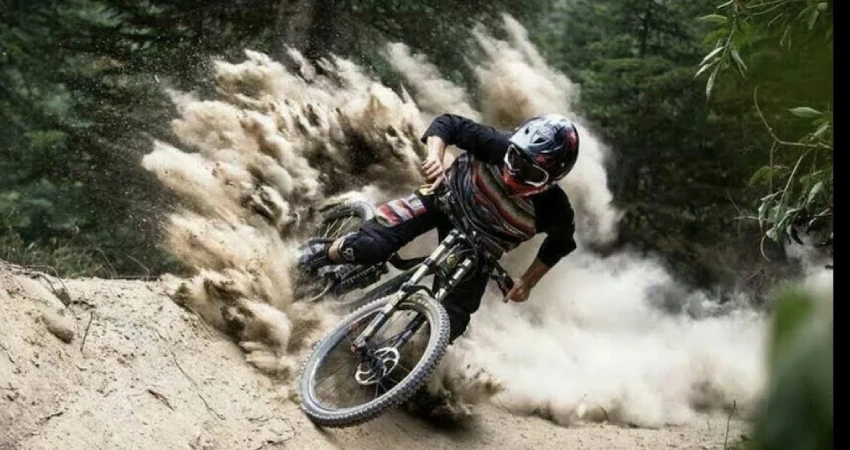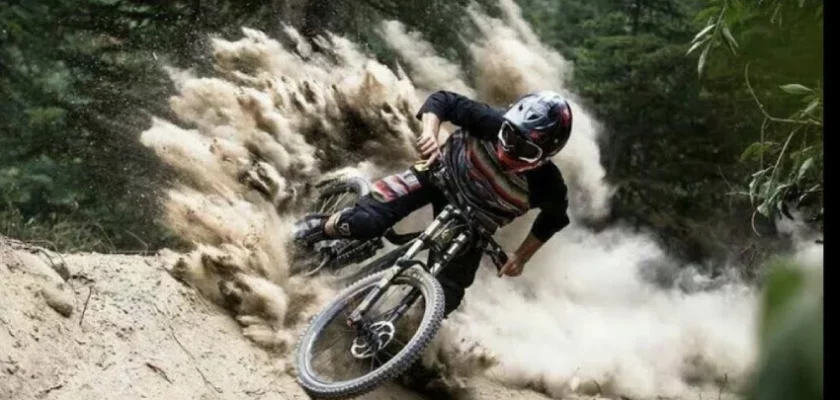Are you ready to learn how to roost on a mountain bike like a pro? Well, you’ve come to the right place! In this article, we will dive into the exciting world of roosting and explore the techniques and skills required to master this thrilling maneuver.
Roosting on a mountain bike refers to the art of sending dirt flying in all directions as you slide and drift through corners with style and control. It’s an eye-catching move that not only looks impressive but also adds an element of fun to your riding experience.
Whether you’re a seasoned mountain biker or just starting out, knowing how to roost can take your skills to the next level.
So, if you’re eager to leave an epic trail of dirt in your wake and leave your friends in awe, keep reading! We’ll uncover the secrets behind how to roost on a mountain bike and help you become a master of this exhilarating technique.
Mastering Mountain Bike Roosting

Mountain biking is an exhilarating sport that allows riders to connect with nature, challenge themselves, and experience the thrill of speed and skill. One of the most exciting techniques in mountain biking is roosting, also known as drifting or power sliding.
Roosting refers to intentionally breaking traction in a controlled manner while cornering, leaving a trail of loose dirt or gravel behind. If you’re looking to take your mountain biking skills to the next level, learning how to roost is a must. In this guide, we will explore the art of roosting on a mountain bike, step by step.
1. Choose the Right Conditions
Not all trail conditions are ideal for roosting, so it’s important to choose the right conditions to practice this technique. Here are some factors to consider:
- Loose terrain: Look for trails with loose dirt, gravel, or sand, as this type of surface allows for better traction breakage.
- Wide corners: Find corners that are wide and open with a good amount of space to drift through.
- Dry weather: Roosting requires better traction breakage, so it’s best to attempt this technique on dry trails.
2. Get Your Body Position Right
Proper body position is crucial for successfully roosting on a mountain bike. Follow these steps to achieve the correct body position:
- Bend your knees: Keep your knees bent and relaxed to absorb impacts and maintain balance.
- Lower your center of gravity: Shift your weight down and towards the pedals to increase stability.
- Get behind the saddle: Slightly shift your body weight backwards, positioning yourself behind the saddle.
- Keep your elbows up and relaxed: This helps maintain control and balance throughout the maneuver.
3. Master Braking and Throttle Control
Understanding how to control your bike’s brakes and throttle is essential for executing a perfect roost. Here’s what you need to know:
- Feathering the brakes: Apply gentle pressure to the brakes to initiate the slide. Feathering the brakes allows you to break traction without losing complete control.
- Manage your throttle: As you enter the corner, release the brakes gradually while simultaneously applying power to the pedals. This controlled release of both brake and throttle will enable you to drift smoothly.
- Practice timing: Finding the right balance between braking, releasing the brakes, and applying throttle takes practice. Start with slow speeds and gradually increase as you get more comfortable with the technique.
4. Focus on Body Positioning While Drifting
As you start to break traction and drift through the corner, maintaining proper body positioning is key. Remember these tips:
- Look where you want to go: Keep your head and eyes focused on the exit of the corner instead of looking at the ground. This will help you maintain a smoother line and control your drift.
- Lean into the corner: Lean your body into the corner, aligning your upper body with the bike. This helps maintain balance and control throughout the drift.
- Keep it smooth: Avoid jerky movements and sudden shifts in weight. Smooth and controlled inputs will result in a more controlled and aesthetically pleasing roost.
5. Practice, Practice, Practice!
Roosting is a skill that requires practice to master. With time and dedication, you’ll become more comfortable with the technique and will be able to add your own style to your drifts. Here are some additional tips to improve your roosting skills:
- Start slow: Begin with slower speeds and easier corners until you build confidence and control.
- Gradually increase speed: As you become more comfortable, gradually increase your speed to challenge yourself.
- Experiment with different terrain: Once you’ve mastered the basics, try roosting on various types of terrain to enhance your skills and adaptability.
- Seek professional guidance: Consider taking lessons or attending clinics with experienced mountain bike instructors who can provide personalized guidance and feedback.
Remember, roosting is not only about having fun and looking cool; it also helps you maintain control and stability while tackling corners at high speeds. It’s an advanced technique that requires practice, so be patient with yourself and enjoy the learning process.
So, get out there and embrace the thrill of roosting on your mountain bike. With the right conditions, proper body positioning, braking and throttle control, and lots of practice, you’ll soon be drifting through corners like a pro. Happy roosting!
Frequently Asked Questions
1. What is roosting on a mountain bike?
Roosting on a mountain bike refers to intentionally kicking up dirt or mud while cornering, creating a spray effect with the rear wheel.
2. How do I roost on a mountain bike?
To roost on a mountain bike, approach a loose surface corner at speed, lean the bike into the turn, and apply pressure on the pedals while initiating a drift motion with the rear wheel.
3. What bike setup is ideal for roosting?
A mountain bike with wider tires, lower tire pressure, and aggressive tread patterns will provide more traction and control, allowing for better roosting capabilities.
4. Are there any techniques to improve roosting control?
Maintaining a balanced body position, looking ahead through the turn, and modulating the throttle and brakes smoothly can improve control while roosting on a mountain bike.
5. Can roosting damage the trail or environment?
Yes, excessive or improper roosting can cause erosion and damage to the trail and surrounding environment. It’s essential to practice responsible riding and be mindful of the impact on the trail and natural surroundings.
Final Thoughts
Roosting on a mountain bike is an exhilarating and skillful technique that every rider should aim to master. By applying the correct techniques, riders can effortlessly send dirt flying behind them, leaving a spray of excitement in their wake.
To roost effectively, riders must maintain a balanced position, shift their weight properly, and actively engage in controlled braking and accelerating. By doing so, they can create the perfect angle and momentum needed to generate a roost.
So, whether you’re a beginner or an experienced rider, honing your roosting skills will take your mountain biking to another level. Remember to practice in a safe environment, gradually building your confidence and skill. With dedication and perseverance, you too can become a master of roosting on a mountain bike, ready to leave your mark on any trail you conquer.

